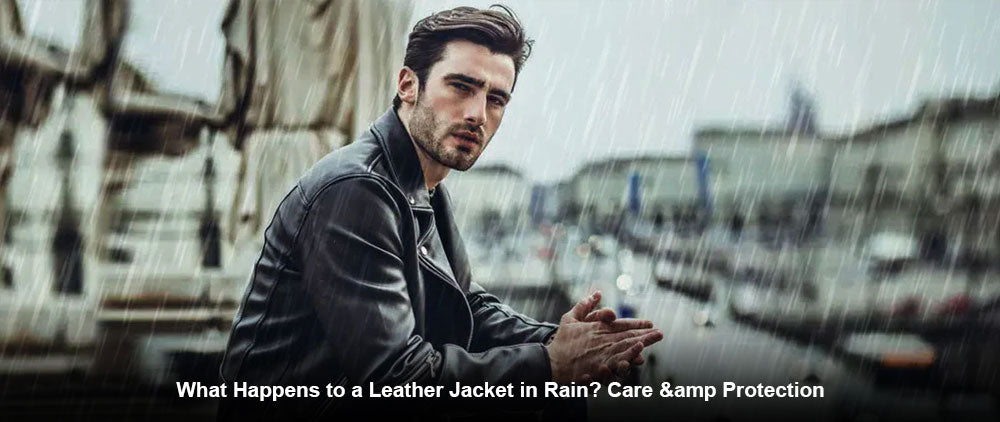A leather jacket is a timeless fashion that you might want to wear in all seasons and occasions. So, what if you are planning to wear it on a rainy day? Are you concerned about whether is rain bad for leather jackets? Well, the answer is, you can wear your leather jacket outfit on a rainy day. But to do that, you must follow some maintenance tips to keep it in perfect condition so that it can bear water. However, you must avoid wearing it in heavy rain every other day or letting it soak in water.
Going out in the rain, especially for a motorcycle ride, is the most beautiful and fantastic feeling. Whenever you ride in the rain, you need proper motorcycle gear to keep yourself safe from the rain. Most of the bikers wear leather jackets, so they might have a question ‘Can You Wear a Leather Jacket in the Rain?’ Let’s talk about this in detail:
Can you wear a leather jacket in the rain?
A leather jacket for men is an iconic, stylish piece of clothing in a wardrobe, but is it okay to wear leather in the rain? Wearing leather in the rain may not cause a problem if it happens only once or twice in a lifetime. But wearing your leather jacket during the rain every time is not something we appreciate. It is because rain can damage the flexible and permeable material of a leather jacket by removing essential oils and making it prone to dryness and peeling.
Leather is a strong and long-lasting material, but it still has the tendency to become impaired if it is not handled with care. Leather is a type of material that usually reacts with humidity, water, and temperature. So, if you are exposing your leather jacket to water or rain, you are providing it with an environment that can cause discoloration and stiffness.
Leather can withhold or resist some amount of water as it is a water-resistant material. But are leather jackets waterproof? No, leather jackets are not waterproof, and water may reduce the lifespan of your leather jacket. It is essential to quickly dry off extra water and allow your jacket to air dry away from direct heat to prevent damage. A leather jacket may stay fashionable and useful, but with good maintenance.
What happens if your leather jacket gets wet in the rain?
Can real leather get wet? Yes, leather is a porous material, which means it can absorb water and get wet. If your leather jacket has become wet, you need to air dry it immediately, otherwise it can cause any of the following problems:
- When exposed to rain, your leather jacket will absorb the water instead of repelling it because of its porous nature.
- If it becomes wet, your leather jacket can lose its natural oils, as it comes from cowhide.
- After losing essential moisture, a leather jacket becomes stiff or hard.
- Without proper care and maintenance, after some time, the hardened leather jacket starts cracking.
- Your leather jacket may catch stains after becoming wet. The improper drying can also leave water marks.
- If you store your leather jacket without letting it dry, it might grow mold because of being damp.
What type of leather can you wear in the rain?
When it comes to wearing leather in the rain, not all types are created equal. Some handle moisture better than others, so let’s break it down:
Full Grain Leather:
Full-grain leather material is the outer layer of the hide on which no process has been performed. This is the most durable and natural type of leather. It is water-resistant to some point, but usually absorbs water over time, even more than the other types of leather.
Top Grain Leather:
Top-grain leather is slightly thinner and less durable than full-grain, but is more resistant to water after treatment. The surface of this type of leather jacket appears smoother and is a decent option for light rain, but it still needs extra care.
Bonded Leather:
The bonded leather jacket is a bad choice to wear in the rain because it is made up of both leather and synthetic material. The outer layer of leather is bonded with the layer of fabric underneath, so it doesn’t hold up well in wet conditions.
Faux Leather (PU Leather):
Faux leather is made from synthetic materials, so it doesn’t absorb water like real leather. Plus, it is low maintenance and budget-friendly. Wearing a faux leather jacket is the best option for your bike rides during the rain.
What type of leather reacts more when exposed to rain?
Bonded leather and genuine leather react more with water as compared to other synthetic and top-grain leather jackets. No leather is fully waterproof, so you may need to take care of your leather jacket, irrespective of the type used in its making. Is lambskin leather waterproof? No, lambskin leather is also not waterproof. In fact, it is one of the most delicate leathers that can be damaged if exposed to rain for a longer period of time.
What should you do after your leather jacket gets wet?
Just like you must know about the leather jacket styling guide, you need to learn its maintenance technique. It is not an unusual thing if you find yourself in a situation where you face unpredictable weather like rain, and you are wearing your favorite outfit of a leather jacket. Leather jacket water damage is an understandable thing, but here are some of the tips you can follow when your jacket gets wet due to rain:
- Try to cover your jacket or immediately find cover if caught in an unexpected rain.
- Do not leave your leather jacket to let it dry itself. Take a clean piece of cloth and absorb the water from your leather jacket.
- Hang your leather jacket in a shady place and not in direct contact with excess heat or sunlight.
- Wait for a day to dry your leather jacket completely.
- After a day, use leather conditioner and apply it to the surface of your leather jacket. It is essential to prevent dryness and cracking.
- Use a place to store your leather jackets where humidity is balanced and the temperature is normal.
How to protect leather jacket from rain?
Do you know that you can make your leather jacket resistant to the rain? Yes, it is possible. Although you cannot completely make your leather jacket waterproof, there are some ways to protect your leather jacket from rain. You can add extra protective layers to make your leather jacket resistant to water.
How to waterproof a leather jacket? Here are some easy methods described below in detail:
Apply a layer of beeswax on your leather jacket:
- Clean the surface of your leather jacket and remove all the dust particles.
- Apply a layer of wax on your leather jacket by using a clean, soft cotton cloth.
- Spread the layer evenly to make a protective layer.
- Let it dry for 30 minutes. During this time, do not put your leather jackets near heat sources, as it can damage the fabric.
- After it gets dry, remove the wax with a clean cloth and then store it.
Apply water-resistant leather lotion:
- Water-resistant leather lotions are also available commercially, which protect your leather jacket from the rain.
- Like beeswax, apply a layer of water-resistant lotion on your leather jacket.
- Let it dry for some time, and then remove the lotion with a clean piece of cloth.
Apply leather conditioner:
- Apply leather conditioner on your leather jacket in a circular motion.
- If some parts of your leather jacket have creases, you can pay special attention by applying the conditioner.
- Wait for some time to let the leather jacket absorb the conditioner.
- Repeat the process more often to increase the lifespan of your leather jacket.
- You can also apply olive oil on your leather jacket to condition it, if you do not have a commercial high-quality leather jacket conditioner.
Use silicone spray on your leather jacket:
- Silicone spray is a waterproof spray that will protect your leather jacket from getting wet.
- Buy high-quality silicone spray from the market with good reviews.
- Clean your leather jacket surface with a clean cloth.
- Apply the spray uniformly on your leather jacket to make a layer of silicone.
- The silicone layer protects the jacket and prevents water from seeping into your leather jacket.
Use effective handling:
If you take care of your leather jacket and store it in a favorable environment, and also apply conditioner, you can increase the lifespan of your leather jacket. Using effective handling techniques strengthens your leather jacket and can make it resistant to light rain.
Alternative Materials to wear in the rain:
While real leather needs protection from heavy rain, you can still plan to wear it with smart leather jacket outfit ideas. If you are looking for alternatives to leather for rain protection, there are several materials that offer excellent durability and weather resistance while being easier to maintain in wet conditions. Here are some popular options:
Waxed Cotton:
Waxed cotton is a classic choice for wet weather. The fabric is treated with a wax coating, making it water-resistant and breathable. It’s lightweight, comfortable, and often used in stylish raincoats or jackets.
Nylon:
Nylon is a popular synthetic material for rain gear due to its lightweight and water-repellent properties. Jackets made from nylon are great for keeping dry during light or heavy rain and are easy to pack when not in use.
Polyester:
Similar to nylon, polyester is widely used in rain jackets and outdoor gear. It is naturally water-resistant and often treated with additional coatings to enhance its waterproof capabilities.
PVC (Polyvinyl Chloride):
PVC is used in raincoats and jackets for complete waterproofing. It’s highly effective at blocking water, though it can feel less breathable compared to other materials.
Gore-Tex:
Gore-Tex is a premium material known for being both waterproof and breathable. It’s a top choice for outdoor enthusiasts who need reliable rain protection without sacrificing comfort.
These alternatives provide excellent rain protection and suit different styles, budgets, and needs!
Ending Remarks:
It is possible to wear a leather jacket in light rain, but it is very important to follow the leather jacket care instructions to prevent damage. Leather is porous, so it can absorb water and can lead to issues like stiffness and cracking if not dried properly. Full-grain and top-grain leather are more suitable options, while bonded leather and faux leather are better to wear during rain.


